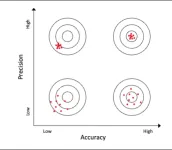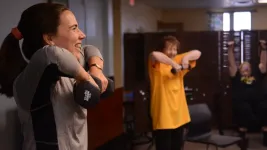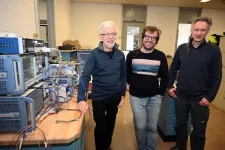(Press-News.org) RIVERSIDE, Calif. -- Their popularity makes celebrities easy to spot. Strangers, however, can also get mistaken for celebrities, resulting in cases of false “celebrity sightings.” In attempting to explain the contradiction, a University of California, Riverside, study reports that celebrity faces are remembered more precisely but less accurately.
Precision, in this context, refers to how memories for a particular face resemble each other over repeated memory retrievals, which can be likened to the clustering of arrows on a target in archery. Accuracy measures how remembered faces resemble newly encountered faces — or the deviation from the target in archery.
“What our findings say is that people might accept errors by misidentifying someone as a celebrity in the interest of securing a ‘celebrity sighting,’” said Weiwei Zhang, an associate professor of psychology, who led the study that appears in the journal Psychonomic Bulletin & Review. “Our study explains why people are good and bad at spotting celebrities and highlights the importance of assessing both memory imprecision and bias in memory performance.”
The study tested 52 college students’ memory for morphed faces that looked like the celebrities Anne Hathaway, Brad Pitt, Zendaya Coleman, or George Clooney. The goal was to assess whether and how prior familiarity with celebrities affects participants’ memory performance.
The researchers collected a total of eight face stimuli: those of Hathaway, Pitt, Coleman, and Clooney, and four non-celebrity faces. Participants were first briefly presented with a photo of a celebrity or non-celebrity. After a short interval, they were presented with a test face and asked if it was the same face as the studied face (test faces were the same half the time and altered the rest of the time). For instance, if the first photo was 100% celebrity, the test face could be altered to 78% celebrity 50% of the time, Zhang said. The same procedure was followed when participants were first shown photos of non-celebrities.
“We found that familiarity with celebrities led to sharpened and more precise memories for celebrities as compared to non-celebrities,” he said. “But it also led to impaired memory accuracy, where celebrity lookalikes or morphed faces were misremembered as celebrities.”
According to Zhang, the findings can help explain a tradeoff in human behavior.
“Familiarity with celebrities in our study is key for the variance-bias tradeoff in face recognition for celebrities,” he said. “We don't seem to do this for anyone else.”
Bias and variance are prediction errors. The total error is the sum of these two error terms, resulting in a trade-off between the two. In machine learning, bias is the difference between the average prediction and the correct value. Variance is a measure of the spread of data points. The variance-bias tradeoff, as its name suggests, is the tradeoff between variance and bias. Finding a good balance between these prediction errors helps minimize the total error.
Zhang explained that human cognition appears to work like machine learning; where cognition is concerned, variance, which is the opposite of precision, and bias, which is the opposite of accuracy, would need to trade off each other to maximize the opportunity to process and represent information.
“The conventional wisdom is that we want our memory to be super accurate and precise,” he said. “But such a rigid memory would not be able to accommodate the variance seen in natural stimuli. For instance, with different lighting conditions, makeup, dresses, and hairstyle, a person’s look can vary greatly. Our memories have to be noisy and vague enough — high variance — to support face recognition with all the variance we find in looks. However, when our memory is vague, face recognition can fail from time to time, which is not optimal in celebrity sightings, given that we don't want to miss encounters with celebrities. So as a solution, we introduce recognition biases in the mix. We start identifying strangers or celebrity lookalikes as celebrities as an overcorrection for vague memories.”
Zhang is unsure if the findings have applications beyond faces — to objects and places, for example.
“It is at least theoretically possible that the variance-bias trade off may be extended to objects and places of importance to individuals,” he said. “We think our findings may be related to déjà vu experiences in that we may have inaccurate but subjectively strong memories.”
Next, the research team plans to conduct research to assess how memory accuracy and precision interact with each other and how these two aspects of memories are encoded in the brain.
Zhang was joined in the study by Bo‐Yeong Won and Hyung‐Bum Park. Won is now an assistant professor of psychology at California State University Chico. Park is now a postdoctoral fellow at the University of Chicago.
The study was funded by the National Institute of Mental Health, the lead federal agency for research on mental disorders.
The research paper is titled “Familiarity enhances mnemonic precision but impairs mnemonic accuracy in visual working memory.”
The University of California, Riverside is a doctoral research university, a living laboratory for groundbreaking exploration of issues critical to Inland Southern California, the state and communities around the world. Reflecting California's diverse culture, UCR's enrollment is more than 26,000 students. The campus opened a medical school in 2013 and has reached the heart of the Coachella Valley by way of the UCR Palm Desert Center. The campus has an annual impact of more than $2.7 billion on the U.S. economy. To learn more, visit www.ucr.edu.
END
Celebrity sightings have a built-in contradiction
UC Riverside research helps explain a tradeoff in human behavior
2023-03-08
ELSE PRESS RELEASES FROM THIS DATE:
A new class of drugs could prevent resistant COVID-19 variants, study finds
2023-03-08
New Haven, Conn. — The constant evolution of new COVID-19 variants makes it critical for clinicians to have multiple therapies in their arsenal for treating drug-resistant infections. Researchers have now discovered that a new class of oral drugs that acts directly on human cells can inhibit a diverse range of pathogenic SARS-CoV-2 strains.
In their newly published study, the team found a novel mechanism through which the gene that expresses angiotensin converting enzyme-2 (ACE-2)—the cellular receptor to which SARS-CoV-2 ...
Swan Hellenic and SETI Institute announce lecturers for Explore Space at Sea Series
2023-03-08
March 8, 2023, Mountain View, CA – The SETI Institute and Swan Hellenic announce SETI Institute guest lecturers who will offer cruise guests expert insights into the history and latest discoveries in astronomy, astrophysics, astrobiology and planetary science, and the quest to find other forms of life within and beyond our solar system. This quest takes SETI Institute researchers to the planet’s most remote and inhospitable corners to explore life, including Antarctica, where the Swan Hellenic fleet is present for several months every year.
Outlining ...
New articles for Geosphere posted early online
2023-03-08
Boulder, Colo., USA: GSA’s dynamic online journal, Geosphere, posts articles online regularly. Topics this month include an analysis of geoscience job applications; Uturuncu volcano, Bolivia; Picture Gorge Basalt; and the Red Bluff Granite Suite. You can find these articles at https://geosphere.geoscienceworld.org/content/early/recent .
Critical workforce skills for bachelor-level geoscientists: An analysis of geoscience job advertisements
G.W. Shafer; K. Viskupic; A.E. Egger
Understanding the skills ...
Human Brain Project: spin-off receives EIC grant to develop energy-efficient AI technology
2023-03-08
The European Innovation Council (EIC) has recently announced that it will award a Transition grant to SpiNNcloud Systems GmbH, a deep-tech startup based in Saxony, Germany.
The team from SpiNNcloud Systems GmbH, a spin-off from Professor Christian Mayr’s research group at Technische Universität Dresden, is receiving a grant of 2.5 million euros for their groundbreaking project, “SpiNNode: SpiNNaker2 on the edge.”
“SpiNNaker2 is a bio-inspired supercomputer which was developed at my Chair in collaboration with Prof. Steve Furber’s research group at the University of Manchester as part ...
New GSA Bulletin articles published online ahead of print
2023-03-08
Boulder, Colo., USA: The Geological Society of America regularly publishes articles online ahead of print. GSA Bulletin topics studied this month include the nature and dynamics of China and Tibet; the Lower Mississippi Valley, USA; and the polarity of Mesozoic arcs along the western margin of North America. You can find these articles at https://bulletin.geoscienceworld.org/content/early/recent .
Magmatic-hydrothermal evolution of long-lived Nb-Ta-(Sn) mineralization in Lianyunshan, NE Hunan, South China
Nuerkanati Madayipu; Huan Li; Safiyanu Muhammad Elatikpo; Michael W. Förster; Hou-Xiang Zhou ...
The ...
Group exercise program for older adults led to more independent exercise despite pandemic restrictions, MU study finds
2023-03-08
COLUMBIA, Mo. -- Sticking with an exercise program can be tough, even during the best of times. But what about during a pandemic?
A new study by the University of Missouri and Oklahoma State University found that even when gyms were closed and there were other COVID-19 restrictions limiting face-to-face meetings, older adults who completed the Stay Strong, Stay Healthy exercise program — created at MU in 2005 — continued to maintain long-term exercise habits independently, which resulted in improved lifestyle changes and an increase in both physical energy and self-confidence.
“We ...
Incident atrial fibrillation appears to heighten dementia risk
2023-03-08
People with a recent diagnosis of atrial fibrillation (AF), the most common irregular heart rhythm, have a modestly higher risk of developing dementia than people without the condition, according to research published today.
“Previous studies that have examined the link between atrial fibrillation and dementia have yielded conflicting results, and we hope that our study’s large sample size helps to establish confidence in our findings,” said Dr. Nisha Bansal, a professor of medicine at the University of Washington School of Medicine. “The study also included a community based, diverse population, which may increase the generalizability ...
Lunar telescope will search for ancient radio waves
2023-03-08
UPTON, NY—Scientists at the U.S. Department of Energy’s (DOE) Brookhaven National Laboratory are leading a new effort to land a radio telescope on the moon. If successful, the project will mark the first step towards exploring the Dark Ages of the universe.
The Dark Ages are an early era of cosmological history starting about 380,000 years after the Big Bang. There were no stars or planets in the Dark Ages. It’s a point in time that scientists have never been able to observe. Though radio waves from the Dark Ages still linger in space, the abundance of radio interference on Earth has masked these signals from scientists seeking to study them.
If ...
How a metabolite causes inflammation and disease
2023-03-08
A new study shows for the first time a connection between a mitochondrial metabolite and the activation of an inflammatory response. Mitochondria are functional units of our cells that fulfil important tasks, i.e. chemical reactions, for the functioning of the cell. One of these tasks is the production of energy that is necessary for cell growth and reproduction. If certain chemical reactions in the mitochondrion change, diseases occur. For example, deficiencies in fumarate hydratase (FH) in the Krebs cycle, one of the most important metabolic pathways in mitochondria, ...
'Other' race/ethnicity linked to higher suicide and overdose risk in military members with mild TBI
2023-03-08
March 8, 2023 – Previous studies have reported high rates of death by suicide and drug overdose – including opioid overdose – in military service members with a history of mild traumatic brain injury (mTBI). A new study finds that those risks are highest among military members with mTBI who identify their racial/ethnic status as "Other," as opposed to standard racial/ethnic categories, reports the March/April issue of the Journal of Head Trauma Rehabilitation (JHTR). The official journal of the Brain Injury Association of America, JHTR is ...
LAST 30 PRESS RELEASES:
AI overestimates how smart people are, according to HSE economists
HSE researchers create genome-wide map of quadruplexes
Scientists boost cell "powerhouses" to burn more calories
Automatic label checking: The missing step in making reliable medical AI
Low daily alcohol intake linked to 50% heightened mouth cancer risk in India
American Meteorological Society announces Rick Spinrad as 2026 President-Elect
Biomass-based carbon capture spotlighted in newly released global climate webinar recording
Illuminating invisible nano pollutants: advanced bioimaging tracks the full journey of emerging nanoscale contaminants in living systems
How does age affect recovery from spinal cord injury?
Novel AI tool offers prognosis for patients with head and neck cancer
Fathers’ microplastic exposure tied to their children’s metabolic problems
Research validates laboratory model for studying high-grade serous ovarian cancer
SIR 2026 delivers transformative breakthroughs in minimally invasive medicine to improve patient care
Stem Cell Reports most downloaded papers of 2025 highlight the breadth and impact of stem cell research
Oxford-led study estimates NHS spends around 3% of its primary and secondary care budget on the health impacts of heat and cold in England
A researcher’s long quest leads to a smart composite breakthrough
Urban wild bees act as “microbial sensors” of city health.
New study finds where you live affects recovery after a hip fracture
Forecasting the impact of fully automated vehicle adoption on US road traffic injuries
Alcohol-related hospitalizations from 2016 to 2022
Semaglutide and hospitalizations in patients with obesity and established cardiovascular disease
Researchers ‘listen in’ to embryo-mother interactions during implantation using a culture system replicating the womb lining
How changing your diet could help save the world
How to make AI truly scalable and reliable for real-time traffic assignment?
Beyond fragmented markets: A new framework for efficient and stable ride-pooling
Can shape priors make road perception more reliable for autonomous driving?
AI tracks nearly 100 years of aging research, revealing key trends and gaps
Innovative techniques enable Italy’s first imaging of individual trapped atoms
KIER successfully develops Korea-made “calibration thermoelectric module” for measuring thermoelectric device performance
Diversifying US Midwest farming for stability and resilience
[Press-News.org] Celebrity sightings have a built-in contradictionUC Riverside research helps explain a tradeoff in human behavior





